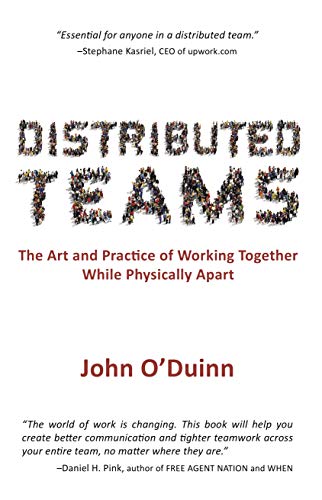Managing Communication in Distributed Teams

With organizations increasingly adopting distributed team approaches for their workforce, new and frequently unanticipated communication challenges are surfacing requiring novel or at least highly considered approaches to solve. Project teams particularly are susceptible to many of these issues as, by their very nature project teams are formed for a specific task and then dissolve either back into the host organization or, into the more general workforce. Many insights gained in one project can easily be lost to future projects.
Among the many novel challenges which are typically encountered by these distributed teams is the question of how to best manage communications between office locations, when the offices may be separated not just by distance but also by time zones. As the time zones separating offices become increasingly spread so also does the difficulty of communication grow.
Even in project structures where the offices reside in the same time zone, and potentially even in the same city, getting personnel who are not physically co-located to talk to one another is challenging and requires specific planning. When project personnel are separated by time zones, and the level of separation may mean that it is night time at one office, while the other is working, as happens where there is a 10 to 14 hour time difference, the options for effective communication become increasingly limited.
There are therefore, different strategies to consider and implement as the time zone separation increases to allow the project to function in a controlled manner and minimize the stress placed on personnel.
Same time zone to 4 hours difference
Managing a project with a time zone separation of between zero and up to 4 hours provides a reasonably substantial level of overlap of time between locations. This overlap allows the use of synchronous tools such as telephone and video connections, along with traditional use of asynchronous tools like email. Properly planned meetings can still be held without undue time pressures on staff from each office to attend the meeting earlier than their normal workday start or to remain after their normal workday finishes.
Planning is still needed however, to avoid instances such as personnel in the office that starts earliest pushing work to the other, later office at the close of the earlier offices day as this risks work commencing without all the details being confirmed and understood and potentially results in wasted effort, it is best for the earlier office to contact the later office at the start of the later offices normal working day so any tasks can be discussed and agreed without time pressure.
Between 4 and 8 hours difference
As the time zone separation between offices increases toward 8 hours, or the duration of a standard working day should it be longer than 8 hours, the ability to talk synchronously diminishes. The project will begin to rely increasingly on written, asynchronous communication and out of hour’s verbal discussions by telephone or video. Synchronous communications such as weekly team teleconference meetings start to become problematic since they need to occur either at the very start or very end of the working day, meaning that personnel must either remain in the office later than their normal finish time, having to attend the office early or being unable to join the meeting because of personal pressures.
The growing reliance on written communication resulting from this degree of separation can then lead to left frequent and less rich discussions, with the resultant formalization of relationships, potential breakdowns of trust and things starting to be missed.
Beyond 8 hours difference
Once the time difference between locations exceeds a normal working day, the ability to have any form of synchronous communication reduces to only out of hour’s discussions, where how ever the discussions are arranged, at least one party will be joining outside standard hours. Some projects address this by imposing a time shift for either the day of the meeting or permanently on one or more office, others will simply expect that personnel will attend these out of hours meetings as part of their job. Both solutions will place additional fatigue and work and personal life stress on those affected, and have the risk of eroding goodwill and relationships within the distributed project team if allowed to run for too long.
Without easy, synchronous, communications project teams begin to rely exclusively on asynchronous tools such as email, and consequently the form of communications within the project team will become more formal and less organic as personnel must write all communication and send them, rather than have verbal discussions accompanied where necessary by email, with the email used to record actions and confirm understandings.
The use of shared file servers is a common feature of most modern projects and while it allows teams to share documents simply and ensures that all parties are working to current information, server files are not a substitute to communications via voice, voice with video, or even email.
Stresses of large time zone differences
Communicating with project offices separated by large time zone differences imposes substantial levels of stress on the individuals, and distributed teams involved. It is not uncommon for team members and, on occasion project managers to burn out from the stress and fatigue of trying to hold on to communications and coordinate events happening at multiple locations around the globe, leading to personnel churn and loss of history. The stress risk is particularly the case for project managers who have been accustomed to managing single location projects, where they have been able to see all the work being done around them, when some of these project managers are faced with trusting that work is happening in multiple locations they can’t see, the stress of not knowing can start to eat away at their confidence.
At the team member level, similar stress levels are often brought about by the pressures of working extended days to communicate to their colleges, or experiencing an increased level of unanticipated rework as tasks which were thought to be compete are found to be deficient because of break downs in communication, putting additional pressures on budgets, schedules, and labor.
Managing these issues is a complex challenge, it starts with establishing a sensible schedule that allows for the potential time delays of getting things right at distance, and a budget that allows for the staffing levels needed to coordinate such work, along with allowances for costs for more travel to maintain coordination. Once these things are in place it is then incumbent on the entire project team to be vigilant to things falling between the gaps, be tolerant of each others time pressures and to accept a higher level of ambiguity than would typically be expected in a collocated team.
Related Articles
Related Books on Amazon
Working Remotely: Secrets to Success for Employees on Distributed Teams
In Working Remotely, authors Mike, Holly, and Teresa discuss how to ward off toxic levels of loneliness, how to get what you need from colleagues spread across the world, and how to network and grow…
Distributed Teams: The Art and Practice of Working Together While Physically Apart
Why distributed teams are good for business, diversity, employee retention, society and the environment. How to run efficient video calls and meetings while dealing with lots of email and group chat.…
Collaboration: How Leaders Avoid the Traps, Build Common Ground, and Reap Big Results
In Collaboration, author Morten Hansen takes aim at what many leaders inherently know: in today's competitive environment, companywide collaboration is an imperative for successful strategy execution,…
Actionmint's articles are about productivity, collaboration, entrepreneurship & project management. Everything about getting your work done.
Subscribe and get your daily mints by email or RSS


















